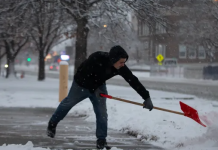From the Office of Public Affairs | http://www.news.ku.edu
Headlines
Contact: Rick Hellman, KU News Service, 785-864-8852, [email protected], @RickHellman
Professor spreads the gospel of ‘good fire’ through an eco-cultural lens
LAWRENCE — A pyromaniac is someone unhealthily obsessed with the destructive power of fire. Melinda Adams instead is pulled toward the term pyromantic – a lover of “good fire” for the benefits it can bring to people, communities and the environment as a whole.
The Langston Hughes Assistant Professor in Indigenous Studies & Geography & Atmospheric Science at the University of Kansas, Adams extols the benefits of cultural or ceremonial fire in a new paper she has co-written for the journal Ecopsychology.
Adams collaborated on the paper, titled “Solastalgia to Soliphilia: Cultural Fire, Climate Change, and Indigenous Healing,” with Erica Tom, instructor in English at the Santa Rosa (Calif.) Junior College, and Ron Goode, honorable chairman of California’s North Fork Mono Tribe. They detail the benefits to university students and community members who took part in a series of ceremonial burns on Indigenous lands in California that they organized as part of ongoing community-based participatory research project in partnership with the University of California-Davis (where Adams obtained her doctorate) and the Southwest Climate Adaptation Science Center.
The researchers wrote that by taking part in a ceremonial burn (the term Goode and Adams both use) a few acres at a time — usually through pile burning or grass burning for the restoration of culturally significant plants — and guided by traditional environmental knowledge, the participants shifted in significant ways from the “Solastalgia” of the paper’s title — a word coined by Australian philosopher Glenn Albrecht for looming environmental dread — to “Soliphilia,” defined as a heightened state of environmental awareness and concern, which the authors say also engenders feelings of control.
“Whether you are a Native person that’s learning about fire, an allied person that’s wanting to learn about the presence of Indigenous peoples and our land stewardship and climate solutions, or community members that care about the places that we all live and work in and hopefully all care about, there’s a role for everybody in learning about good fire,” Adams said.
As wildfires have grown larger and more frequent as the result of climate change, so, too, has the fear of them grown in the Western states.
“We’ve had young people and students who experienced the Carr Fire or the Paradise fire, so they’ve lost their family homes or been affected in some way,” Adams said. “Or they were already afraid of fire from engrained ideas that all fire is bad fire. So students participated in the ceremonial burn demonstrations to learn an Indigenous perspective of not running from fire but working with it as a land stewardship tool. The experience is powerful as a healing concept. … There’s growing interest in cultural fire because it’s a mitigation tool that people are starting to educate themselves about. These are practices that we have held onto, as Indigenous peoples, since time immemorial.”
Adams studies and leads cultural/ceremonial fire from an Indigenous lens and invites others to learn from traditional practices, with Indigenous peoples always leading these demonstrations. She says her eco-cultural work serves to reiterate what Indigenous communities have always known: Through close connections with lands and waters, and scientific observation over time, there are numerous benefits to purposely lit cultural fire.
“In addition to the cultural-social effects of cultural fire, I also study the soil effects of cultural fire, of native fire, and its potential for carbon storage — everybody’s raving about carbon storage with climate effects – and I also talk about the water-holding capacity that good fire invites to soilscapes,” Adams said.
The authors wrote that the benefits of “placing fire on the land” can be expanded from an individual to an environmental level as participants in programs like the one Adams helped lead in California take the lessons they’ve learned into their careers in the field.
Adams, who joined KU’s faculty in spring 2023, led her first ceremonial burn at the KU Field Station in March. She looks forward to more, working with tribes, nearby Haskell Indian Nations University (of which Adams is also an alumna), faculty and community members and Indigenous peoples in the Midwest.
“That’s part of my work in trying to widen the scope of good fire,” Adams said. “We say good fire, meaning it’s purposeful, it has an ecological, cultural or social benefit that it’s bringing, as opposed to catastrophic wildfire, forest fire, which in most of us it’s ingrained to be dangerous and something to stay away from. … Not all fire is bad fire.”
-30-
————————————————————————
KU News Service
1450 Jayhawk Blvd.
Lawrence KS 66045
Phone: 785-864-3256
Fax: 785-864-3339
[email protected]
http://www.news.ku.edu
Erinn Barcomb-Peterson, director of news and media relations, [email protected]
Today’s News is a free service from the Office of Public Affairs




